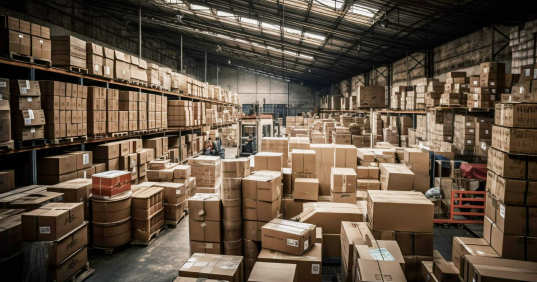
Date : Mar 25, 2024
Organizations of all types and sizes are leveraging online retail technology to offer their goods globally. A winning e-commerce strategy can take your company to the next level, but first, you need to figure out how you’ll manage your inventory and customer service. This is where a warehouse management system (WMS) comes in. These tools give you everything you need to manage products, streamline processes, and save you money. Here’s what you need to know.

What is a WMS and How Does It Work?
A warehouse management system (WMS) is a type of software that is widely used in the manufacturing and retail industries because it tracks all materials and goods as they come in and go out of the warehouse. In basic terms, a WMS helps optimize all your warehouse processes.
It’s extremely important not only because it tracks all materials in your warehouse, but it can also create systems to streamline how workers pick products and pack orders. It provides you with the ability to track merchandise entering the warehouse, being packed onto shelves and into various places, and when it leaves the warehouse for order fulfillment.
Since the warehouse management system has all the information at hand, it can immediately check if the products are available when a customer sends an order. Instead of a person manually cross-referencing the order and the stock, the WMS will automatically mark the order as ready for packing.
Why Use Warehouse Management Systems
Part of the online retail landscape means being able to fulfill any order as efficiently as possible. In order to do that, you need a warehouse management system to understand where all of your materials and goods are in the warehouse to ultimately reduce order latency, processing costs and order errors.
A warehouse management system can help you speed up your order fulfillment, and it can also help you keep track of what is selling well. When you’re able to see which products are leaving the warehouse most often, you can find new ways to optimize its setup. You can track raw materials when they come in and make sure they’re in the best place for stocking and manufacturing. The best-selling products can be next to the loading dock or the packing area, as opposed to being on the opposite end of the space.
Types of Warehouse Management Systems
Integrated Vs. Standalone WMS
- There are two types of warehouse management system software you can use to stay on top of all of your incoming and outgoing product operations.
- An integrated WMS is normally an add-on from your existing Enterprise Resource Planning (ERP) provider, ERP systems manage invoicing, accounting, and tracking inventory. The warehouse management system takes the orders and directs the order picking process, inventory and receiving and shipping of products. When everything is able to integrate into one system, it’s much easier to keep track of which orders are best to invest money in.
- If you have a product that’s selling very well but has a low profit margin, you could choose to restock a product with a higher profit and slightly lower sales instead. You can keep an eye on all of these financial analytics with an integrated warehouse management system.
- A standalone warehouse management system is feature-rich software that primarily serves the function of warehouse management. Therefore, it might have limited functionality for other aspects of your business, such as inventory or accounting. Since it is tailored to warehouse management, this type of WMS can have advanced reporting features that will help you level up your warehouse.
- Overall, the choice depends on how you prioritize tasks in your warehouse.
On-Premises Vs. Cloud-Based WMS
- In basic terms, an on-premises WMS is one in which you are responsible for hosting and maintaining both the hardware and software associated with your system. While this gives you complete control over things like uptime and security, it also comes with a large upfront cost because you are responsible for all components. You will also need to keep your WMS regularly maintained.
- While very small organizations can be comfortable using on-premises WMS, managing everything yourself can be a headache. Alternatively, cloud-based WMS systems are typically charged on a subscription basis, but they are hosted on a remote server. Things like bug fixes and software updates are handled by the vendor, and you typically get a guaranteed level of service uptime when you sign up.
- The more an online retail business grows, the more you need to assess the most effective way to manage all of the products. Customers have high expectations when it comes to shipping and even order packaging these days, so it’s important to eliminate confusion in the warehouse. Saving all the time and resources involved in on-premises systems can be a good way of doing just that.
How do I choose a warehouse management system?
Most organizations should start by deciding what features they need in their system and how much they are willing to spend. After that, they can request more information from a provider about how they can tailor a warehouse management system to their business effectively.
What are warehouse management activities?
In general, all warehouse activities for retail revolve around receiving materials, picking products, preparing documents, and packing orders. A warehouse management system tracks all the activities of the on-site labor and makes it easier to understand.
What are some benefits of a warehouse management system?
Some of the benefits that you might see from a warehouse management system include reduced labor costs because of more efficient labor allocation, more streamlined warehouse processes, improved inventory accuracy, accurate demand forecasting, improvements in warehouse security and safety, a more optimized warehouse layout configuration and improved supplier and customer relationships.
Are warehouse management systems secure?
Like most types of software, the best warehouse management systems offer many levels of security. When choosing this type of system, you want to look for security features like two-factor authentication (2FA) or multifactor authentication (MFA), documentation that shows frequent security updates and patches, intrusion detection, the monitoring of user activities, data encryption and privacy protection.
Related Blogs

A warehouse management system can help you speed up your order fulfillment, and it can also help you keep track of what is selling well.